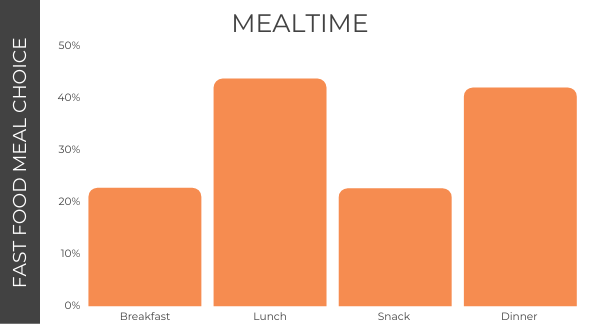The fast-food industry has always been a high-ranked meal option worldwide and it annually has a reasonable growth in its popularity. The widespread trend has a big part in the global industry and restaurant sector thanks to its influence and billion dollars of worth of marketing.
Mcdonald’s, Yum!, Starbucks and more, are some of the biggest names in the industry, but besides their hamburgers, pizzas, and drinks, what are actually the numbers behind their businesses and success?
Has the global food industry exceeded its worth in 2021? Has fast food consumption increased during the pandemic? Who are the employees? These and many more questions are answered in this article. Find all the fast food statistics and facts.
Here are all the fast-food topics we will cover today:
- General Fast Food Facts
- Fast Food Industry & Market Facts
- Junk Food Consumption Statistics
- Fast Food Health Facts
- Fast Food Employee Statistics
- Fast Food Advertising
- Fast Food Estimated Future
Top 10 Fast Food Facts (Editor’s Pick)
- Global fast-food industry revenues exceed $885 billion in 2021.
- Every second McDonald’s sells 75 burgers.
- Fast food is a lunch for 43.7% of people.
- Americans spend $200 billion on fast food annually.
- One-third of children and adolescents eat fast food on a daily basis.
- 76% of fast-food consumers think that fast food is bad for their health.
- Pizza is guilty of more than 80% of overweight problems.
- The fast-food industry has a yearly employee turnover rate of 150%.
- California has over 100,000 fast-food employees.
- A poor diet could increase healthcare costs up to $956 billion.
General Fast Food Facts
1. There are 197,623 fast-food restaurants businesses in the USA.
There is no secret that America is a fast-food capital with just under 200,000 fast-food restaurants. That number of 197,623 has increased in the last year quite rapidly. In 2020, there were 186,290 fast-food restaurants in the USA.
Source: IBISWorld
2. Yum!, Starbucks, and McDonald’s are the biggest names in the fast-food industry.
When it comes to popularity, the biggest names in the fast-food world are Yum!, Starbucks, and McDonald’s. Yum! holds Taco Bell, KFC, and Pizza Hut, and has a total worth of $20.6 billion. Starbucks has a worth of $77.2 billion, while McDonald’s $122.9 billion.
Source: Investopedia
3. Every second McDonald’s sells 75 burgers.
McDonald’s is one of the most popular fast-food restaurants worldwide and it sells 75 burgers per second. That is 4500 burgers in a minute or 270,000 an hour. Now, those are some big numbers.


Source: Mashed
4. Men consume more fast food than women.
The research from Barbecue Lab stated that 38% of men consume junk food on any given day, compared with 35.4% of women. The research showed that young men are particularly big fast-food users.
Source: The Barbecue Lab
5. Around 32% of people eat fast food because they think it is cheaper.
Fast food is quite inexpensive comparing it with other restaurants’ menus and offers, however, it is more expensive than preparing a homemade meal. Around 32% of people eat fast food because they think it is cheaper than any other mentioned alternative.
Source: The Barbecue Lab
6. Fast food is a lunch for 43.7% of people.
According to the Budget Branders study, fast food most often presents a lunch. 42% of people choose it for dinner, 22.7% for breakfast, and 22.6% of them as a snack.


Source: Budget Branders
7. There are over 37,000 McDonald’s restaurants in the world.
Globally, McDonald’s is the most popular fast-food chain. It has more locations than Taco Bell, Wendy’s, Burger King, and Arby’s together and combined.
Source: Budget Branders
Fast Food Industry & Market Facts
8. Americans spend $200 billion on fast food annually.
According to the Budget Branders, Americans are quite big fast-food consumers – they spend roughly around $200 billion on fast food every year.
Source: Budget Branders
9. $70,500 average Americans spend on fast food in a lifetime.
If we look at an entire lifetime, the average American spends $70,500 on fast food in a lifetime, according to the Budget Branders. This may seem funny until you sit, think, and actually write down all the fast food costs. They are rather high, aren’t they?
Source: Budget Branders
10. Fast food generates revenue of over $570 billion globally.
The fast-food industry is well-spread worldwide and it has a huge part in the global market. According to Franchise Help, the fast-food industry generates revenue of over $570 billion globally.


Source: Franchise Help
11. Global fast food industry revenues exceed $885 billion in 2021.
The popularity of fast food during these tough times of the pandemic has certainly increased. Due to that, the global fast-food industry has earned over $885 billion in 2021. And that number will probably be bigger at the end of the year.
Source: Spendmenot
12. The 2021 online food delivery market worth is $151,526 billion.
If we look at the online food delivery market, including all types of fast food, its global worth during 2021 is over $151 billion. Which is not that surprising due to the ongoing pandemic.
Source: Spendmenot
13. QSR has more than 50% of sales in the restaurants’ sector.
The fast-food industry, also known as the Quick Service Restaurants (QSR), accounts for more than 50% of sales in the entire restaurants’ sector. Fast food definitely leads the food industry.
Source: Franchise Help
Junk Food Consumption Statistics
14. A high number of young adults consume more fast food than others.
The percentage decreases with age. 44.9% of young people consume fast food. 37.7% of adults between 40 and 59 eat fast food, while those above the age of 60 are least likely to consume it (24.1%).


Source: Budget Branders
15. The higher the income, the more likely to consume junk food.
The study made by Budget Branders showed that people with higher income (42%) are more likely to go and have a fast food meal. 36.4% of people with middle income and 31.7% of those with lower income will consume such food.
Source: Budget Branders
16. A number of 37% of US adults consume fast food every day.
According to the data brief made by the National Center for Health Statistics, a high number of 37% of US adults (around 85 million of them!) consume fast food on a daily basis.
Source: CNN Health
17. There is a 2.2% annual growth for fast food consumption.
Fast-food consumption has been increasing over the last years and according to Budget Branders, there has been a rough annual growth of 2.2%. The new numbers will certainly be a bit bigger due to the pandemic.
Source: Budget Branders
18. Americans consume the most fast food in the world.
On the worldwide fast food map, things are quite clear – Americans consume junk food more than the rest of the world. France is in second place and Canada in third.
Source: Supplements101
19. One-third of children and adolescents eat fast food on a daily basis.
This is quite a defeating fact. According to the CDC, over one-third of youth consume junk food on a given day. That is a high percentage of 36.3%!
Source: CDC
20. There is 30% of fast-food restaurants that offer healthier items on kids’ menus.
Speaking of kids, 30% of fast-food restaurants actually incorporated healthier food options and items on the kids’ menus. However, due to the quite bigger lists of unhealthy meal options, this often goes off the radar while ordering food.


Source: Reuters
21. Around 90% of American children go to Mcdonald’s every month.
This percentage is rather big, but still, not a surprising one since a lot of people feels that Mcdonald’s meal is cheaper than preparing a homemade meal. Also, it is simpler to go and choose a take-out.
Source: Fast Food Nation
22. There is 34% of children who consume fast food daily.
Still talking about children, 34% of them have a habit of eating fast food every single day which can be rather negative for their body, health, and nutrition.
Source: Budget Branders
23. Around $1200 is spent on fast food per person in a year.
If we look at the annual cost report, $1200 spent on fast food at the end of the year may come as a lot. And it is. $2.49 for a hamburger isn’t a lot per meal until you write down all the costs and see thousands of fast-food money spent.
Source: Renolon
24. McDonald’s sells fast food to about 68 million people daily.
With the biggest popularity and branching, this fact doesn’t come as a surprise. McDonald’s is a worldwide well-known fast food restaurant and it has around 68 million sales daily. Probably more by now. Besides, thanks to the McDonald’s kiosks, the company has an increase of 6% in sales.
Source: Renolon
25. Americans make 18% of all worldwide fast-food sales.
As the biggest fast-food consumers in the world, Americans altogether make 18% of fast-food sales – globally! Which is quite a big percentage to look at.
Source: Renolon
26. Due to the pandemic, 73% of people order take-out food up to twice a week.
The research about the cooking habits in America stated that 73% of full-time employed people order take-out food once or twice a week. Ordering a fast-food take-out certainly increased this past year and maybe just because of one reason – COVID-19.


Source: KitchenToast
27. Chipotle’s digital sales grew over 200% during COVID-19.
As we mentioned in the previous paragraph, the pandemic had a huge impact on consuming fast food, so we can’t say we’re surprised with the fact that Chipotle’s digital sales increased over 200% during the pandemic.
Source: Insider
28. About 76% of fast-food consumers think that fast food is bad for their health.
Despite that high percentage, those people still choose to eat such unhealthy food – whether that decision is just a guilty pleasure, lack of time for meal prep, or a necessary evil.
Source: Budget Branders
Fast Food Health Statistics
29. Fast food meal gives you up to 37% of needed daily calories.
Your body requires a certain amount of minerals, vitamins, and nutrients every day. So you must be quite careful while planning your daily meals because fast food gives your body 37% of altogether the calories needed on a daily basis.
Source: Statistic Brain
30. There are around 836 calories in a fast-food meal.
Speaking of calories, we’re all familiar with the fact that fast food has a big amount of calories in one meal. If we’re talking about a standard fast-food menu, it usually has around 836 calories. Or more.
Source: Barbecue Lab
31. Less than 1% of all kids’ meal combinations meet recommended nutrition standards.
Even though some fast-food restaurants have healthy options on the kids’ menus, less than 1% of all the possible meal combinations have the recommended nutrition standards. That is only 33 meals out of a possible 5,427.


Source: Fast Food Marketing
32. Pizza is guilty of more than 80% of overweight problems.
Consuming fast food on a regular basis leads to obesity/overweight problems. Besides pizza, fried chicken is connected to 40% of obesity problems, while sandwiches with 35%.
Source: JMPH
33. Living near a fast food restaurant is linked to a 5.2% greater risk of obesity.
While looking for easy and cheap meal solutions, people who live near a fast-food restaurant will often turn to it as an alternative for meal prep. But according to the Barbecue Lab, there is a 5.2% greater risk for such people to have problems with obesity.
Source: The Barbecue Lab
Fast Food Employee Statistics
34. The average fast-food employee is 29 years old.
There is an opinion that only young people and students work at fast-food restaurants. However, the research made by Deals On Health actually states that the average age of a fast-food employee is around 29.


Source: Deals On Health
35. There are 4,791,005 people employed in US fast-food restaurants.
In 2021, the US has around 4,791,005 people working in the fast-food industry. The industry now employs more workers than it did five years ago.
Source: IBISWorld
36. To be specific, the number of people employed in the fast-food industry increased by 2.4%.
According to the research made by IBISWorld, there has been an increase of 2.4% in fast-food employment between 2016 and 2021.
Source: IBISWorld
37. This industry has a yearly employee turnover rate of 150%.
This basically means that fast-food restaurants not only change the entire stuff, but once they do that, they change 50% of the next round of the stuff. This tells a lot about the roughness of working in such an industry.
Source: Mashed
38. Around a third of fast-food employees have a higher education.
To follow up the previously mentioned paragraph, and unlike the popular opinion of how the fast-food employees are people with a low degree of education, a third of employees actually have some form of higher education.
Source: Mashed
39. California has over 100,000 fast-food employees.
The research made by Deals on Health stated that California has the most fast-food cooks in the USA.


Source: Deals On Health
40. The average US fast food worker earns $11 per hour.
This is quite a disappointment, but not a surprising fact. According to research, a lot of fast-food employees actually work 2 jobs to have a stable financial status at the end of the month.
Source: Salary
41. Over 50% of employees rely on public assistance programs.
Due to their small salary wage and/or long shifts, many front-line fast-food employees can’t find a second job, so they rely on some type of public assistance program.
Source: Reuters
42. Globally, 26% of fast-food employees have kids.
Speaking of their tough financial situation, it is important to state that 26% of fast-food employees actually have kids. This too is one of the reasons for them to find a second job or rely on the mentioned public assistance programs.
Source: Mashed
43. Every year 87% of employees get injured on the job.
Working at fast food isn’t easy – frying, cutting, and serving is a part of daily tasks, and the number of people who got injured at least once a year is a bit shocking. And it makes it even more shocking due to the fact that most fast-food employees don’t receive any health benefits.


Source: Hart Research Associates
Fast Food Advertising
44. TV food advertising has a 30% higher influence on people.
Study Finds stated that children who were exposed to some of the food TV ads and commercials have 30% higher chances of eating the advertised food. Watching TV or social media truly have a big influence on people’s actions. And kids are the most easier age group to influence.
Source: Study Finds
45. There are up to 5 Fast Foods Ads Showed To Children Daily.
The research made by the Budget Branders stated that kids are exposed to 3 to 5 ads for fast food on a daily basis. As we already said, kids are the most vulnerable group and they can easily be influenced to indulge in unhealthy habits of eating fast food.
Source: Budget Brandes
46. More than 80% of advertising promotes unhealthy food and beverages.
On a daily basis, we can see up to 80% of unhealthy advertising – from fast food and sugary drinks to candy and snacks. Once kids see ads for unhealthy food and beverages, they are definitely more likely to choose such products.


Source: State Of Childhood Obesity
47. Children’s networks have 76% more ads per hour. (Science Daily)
Unlike classic networks, children’s networks are more targeted when it comes to ads. In this case, the viewers are exposed to up to 76% more ads per hour on children’s networks.
Source: Science Daily
48. $5 million worth of marketing daily.
The fast-food industry invests a lot in its advertising. It spends more than $5 million every day on marketing unhealthy food for kids. That is approximately $2 billion per year.


Source: FTC
Fast Food Estimated Future
49. The industry is expected to have a growth rate of 7.5% per year until 2024.
This percentage is the estimated growth made by the fast-food industry statistics. The growth rate of 7.5% per year between 2020 and 2024 in the USA alone is quite big. No question asked of how much influence will that have on the global industry.
Source: Statista
50. $931.7 billion of the estimated worth.
The global market value of the junk food industry is definitely growing. It is estimated that by the end of 2027, the industry will be worth up to $931.7 billion.
Source: Budget Branders
51. By 2050, 1 of 3 US adults will have diabetes.
The research made by the CDC stated that if the fast-food trend keeps increasing, and according to the already mentioned statistic, that increase is inevitable, 1 out of 3 US adults will get diabetes in the period of the next 30 years.
Source: CDC
52. Poor diet could increase healthcare costs up to $956 billion.
Junk food brings the habit of poor diet, especially in the combination with inactivity. At the moment of the research, the healthcare costs were on average $860 billion but due to the popularity of junk food, it is believed that in the next decade, by 2030, these costs could range up to $956 billion.


Source: Obesity
To Wrap It Up
All these statistics and facts give the consumers a better picture of how the fast-food industry actually works, how much is it worth, the influence it has on kids and adults, and the possible consequences on people’s health and future. Even though we’re talking about quite an unhealthy segment of gastronomy, the fast-food sector is a big part of the global industry and its value and popularity will definitely increase even more in the upcoming years.


















Leave a Reply